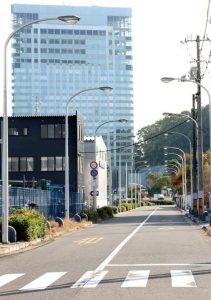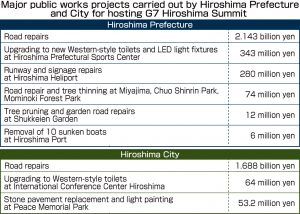Preparations for Hiroshima Summit 2023, Part 1: Infrastructure
Nov. 21, 2022
Huge amount of money for roads and toilets based on “assumptions” about leaders’ travel itinerary
by Yumie Kubo, Taiki Yomura and Yu Kawakami, Staff Writers
Exactly six months remain before the summit meeting of the G7 (the Group of Seven industrialized nations), which will be held in the A-bombed city of Hiroshima during the period May 19–21 next year, 2023. With world political leaders gathering in the city, the Hiroshima City and Prefecture governments are busily preparing to ensure success of the event, convey the charms of Hiroshima, and communicate a message of peace to the world. Herein, the current status and challenges in this effort will be discussed.
Takahiro Morihara, head of a newly created department with eight staff members in Hiroshima City Hall to handle roads for the G7 Hiroshima Summit, said “We’re set to do 10 years of work at one time.” Securing a supplementary budget totaling 1.688 billion yen in September 2022, the department is scheduled to handle road pavement work and the rebuilding of street lighting in Hiroshima’s Naka Ward, where Peace Memorial Park is located, and Minami Ward, the location of the Grand Prince Hotel Hiroshima, a candidate site for the summit’s main venue. The improvement work is to start this month, November, and will be in full swing between January and March next year, 2023.
The Hiroshima Prefecture and City governments appropriated about 10 billion yen by September 2022 for hosting the G7 summit. Of that summit-related budget, improvements to infrastructure and public facilities account for about 7.7 billion yen. The governments have decided to move up the timeline for the work, with the aim of ensuring that vehicles carrying dignitaries could travel smoothly and that a good impression of Hiroshima would be conveyed. The overall budget for the event is expected to rise further.
When the G7 Ise-Shima Summit was held in Mie Prefecture in 2016, operating costs spent by the prefecture totaled about 9.4 billion yen. Of that total, approximately 6.4 billion yen was invested in public works and the development of an international media center, for which the national government provided four billion yen in subsidies. Hiroshima Prefecture Governor Hidehiko Yuzaki and Hiroshima City Mayor Kazumi Matsui both made direct appeals to the national government this month to secure a budget.
Nevertheless, the travel itinerary of the G7 leaders has not yet been announced. One high-ranking prefectural official said, “We have to get everything ready on the basis of assumptions.” Preparations are being made to work on all locations that the leaders might potentially pass by or visit.
Runways and signage part of improvement plan
Unusual public works projects can also be seen in how the outsourcing orders are being placed. For the plans to prune 1,790 roadside trees along the assumed route to and from the main venue, the presumed hotels, and Peace Memorial Park, bids were invited without locations being specified, with approximations instead shown by circles indicated on maps of Naka and Minami Wards. In what was an unprecedented step, the city’s park improvement department personnel have said that such measures were taken for security reasons.
Public works projects are not limited to roads. The prefecture plans to repair the runways and the signage at the Hiroshima Heliport (located in the city’s Nishi Ward), at which then-U.S. President Barack Obama landed in 2016. On Miyajima (in Hatsukaichi City), the island where the government is considering to take G7 leaders for a visit, the renowned Momiji Bridge is to be repainted, with rust removed from the bridge’s piers.
At the Hiroshima Prefectural Sports Center (Naka Ward), which is expected to be used as the international media center, 43 Japanese-style toilets and 141 Western toilets will all be upgraded to new Western-style toilets with washing functions for ease of use by overseas visitors, and lighting will be upgraded to LED lamps.
In preparation for the leaders’ visit to Peace Memorial Park, the city government plans to replace 52 posts used to prevent traffic from entering the area with new posts 1.5 times thicker. A total of 220 square meters of cracked stone pavement will be replaced with the aim of improving the appearance. The 35 Japanese-style toilets in the International Conference Center Hiroshima will also be upgraded to Western toilets.
Planned in anticipation of increased visitor numbers
Shukkeien Garden (Naka Ward), Chuo Shinrin Park (Mihara City), and Mominoki Forest Park (Hatsukaichi City) are included in the prefecture’s renovation list based on the projection that visitor numbers will increase. Some in the prefecture have stated such renovations were not accomplished in the past but the decision was made to go ahead with the work given the opportunity presented by the G7 event.
A huge amount of money will be spent to host the summit, even as residents of the prefecture struggle to get by due to the coronavirus pandemic and price inflation. Toshiyasu Ito, a professor at Hiroshima Shudo University who specializes in public policy, pointed out, “Development work needs to be done from a long-term perspective, not simply as a temporary measure, for the sake of the lives of residents and the comfort of tourists even after the summit.”
(Originally published on November 19, 2022)









